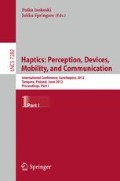Abstract
We present a closed-loop neurorobotic system to investigate haptic discrimination of Braille characters in a reading task. We first encode tactile stimuli into spiking activity of peripheral primary afferents, mimicking human mechanoreceptors. We then simulate a network of second-order neurones receiving the primary signals prior to their transmission to a probabilistic classifier. The latter estimates the likelihood distribution of all characters and uses it to both determine which letter is being read and modulate the reading velocity.
We show that an early discrimination of the entire Braille alphabet is possible at both first and second stages of the somatosensory ascending pathway. Furthermore, 89% of the characters are correctly recognised in a constant-velocity reading task, while a closed-loop modulation of the speed allows for faster scanning and movement kinematics similar to the ones observed in humans –though with a lower classification rate.
Access this chapter
Tax calculation will be finalised at checkout
Purchases are for personal use only
Preview
Unable to display preview. Download preview PDF.
References
Hughes, B., Van Gemmert, A.W.A., Stelmach, G.E.: Linguistic and perceptual-motor contributions to the kinematic properties of the braille reading finger. Human Movement Science 30(4), 711–730 (2011)
Hughes, B.: Movement kinematics of the braille-reading finger. Journal of Visual Impairment & Blindness 105(6), 370–381 (2011)
Johansson, R.S., Flanagan, J.R.: Coding and use of tactile signals from the fingertips in object manipulation tasks. Nature Reviews Neuroscience 10(5), 345–359 (2009)
Gerstner, W., Kistler, W.: Spiking Neuron Models. Cambridge University Press (2002)
Chacron, M.J., Pakdaman, K., Longtin, A.: Interspike interval correlations, memory, adaptation, and refractoriness in a leaky integrate-and-fire model with threshold fatigue. Neural Computation 15(2), 253–278 (2003)
Cannata, G., Maggiali, M., Metta, G., Sandini, G.: An embedded artificial skin for humanoid robots. In: Proc. IEEE International Conference on Multisensor Fusion and Integration for Intelligent Systems MFI 2008, pp. 434–438 (2008)
Bologna, L.L., Brasselet, R., Maggiali, M., Arleo, A.: Neuromimetic encoding/decoding of spatiotemporal spiking signals from an artificial touch sensor. In: Proceedings of the 2010 International Joint Conference on Neural Networks (IJCNN), vol. 10, pp. 1–6 (2010)
Lapicque, L.: Recherches quantitatives sur l’excitation électrique des nerfs traitée comme une polarisation. Journal de Physiologie et Pathologie General 9, 620–635 (1907)
Johansson, R.S., Birznieks, I.: First spikes in ensembles of human tactile afferents code complex spatial fingertip events. Nature Neuroscience 7(2), 170–177 (2004)
Brasselet, R., Johansson, R., Arleo, A., Bengio, Y., Schuurmans, D., Lafferty, J., Williams, C., Culotta, A.: Optimal context separation of spiking haptic signals by second-order somatosensory neurons. In: Advances in Neural Information Processing Systems 22, pp. 180–188 (2009)
Carrillo, R.R., Ros, E., Boucheny, C., Coenen, O.J.D.: A real-time spiking cerebellum model for learning robot control. BioSystems 94(1-2), 18–27 (2008)
Brasselet, R., Johansson, R.S., Arleo, A.: Quantifying neurotransmission reliability through metrics-based information analysis. Neural Computation 23(4), 852–881 (2011)
Shannon, E.: A mathematical theory of communication. The Bell System Technical Journal 27, 379–423, 623–656 (1948)
Rieke, F., Warland, D., de Ruyter van Stevenick, R., Bialek, W. (eds.): Spikes: Exploring the neural code. MIT Press, Cambridge (1997)
Victor, J.D., Purpura, K.P.: Nature and precision of temporal coding in visual cortex: a metric-space analysis. Journal of Neurophysiology 76(2), 1310–1326 (1996)
Schreiber, S., Fellous, J.M., Whitmer, D., Tiesinga, P., Sejnowski, T.J.: A new correlation-based measure of spike timing reliability. Neurocomputing 52-54, 925–931 (2003)
van Rossum, M.C.: A novel spike distance. Neural Computation 13(4), 751–763 (2001)
Zhang, H.: The optimality of naive Bayes. In: Proceedings of the FLAIRS Conference, vol. 1(2), pp. 3–9. AAAI Press (2004)
Truccolo, W., Friehs, G.M., Donoghue, J.P., Hochberg, L.R.: Primary motor cortex tuning to intended movement kinematics in humans with tetraplegia. The Journal of Neuroscience 28(5), 1163–1178 (2008)
Bologna, L.L., Pinoteau, J., Brasselet, R., Maggiali, M., Arleo, A.: Encoding/decoding of first and second order tactile afferents in a neurorobotic application. Journal of Physiology-Paris 105(1-3), 25–35 (2011)
Phillips, J., Johansson, R., Johnson, K.: Representation of braille characters in human nerve fibres. Experimental Brain Research 81(3), 589–592 (1990)
Author information
Authors and Affiliations
Editor information
Editors and Affiliations
Rights and permissions
Copyright information
© 2012 Springer-Verlag Berlin Heidelberg
About this paper
Cite this paper
Pinoteau, J., Bologna, L.L., Garrido, J.A., Arleo, A. (2012). A Closed-Loop Neurorobotic System for Investigating Braille-Reading Finger Kinematics. In: Isokoski, P., Springare, J. (eds) Haptics: Perception, Devices, Mobility, and Communication. EuroHaptics 2012. Lecture Notes in Computer Science, vol 7282. Springer, Berlin, Heidelberg. https://doi.org/10.1007/978-3-642-31401-8_37
Download citation
DOI: https://doi.org/10.1007/978-3-642-31401-8_37
Publisher Name: Springer, Berlin, Heidelberg
Print ISBN: 978-3-642-31400-1
Online ISBN: 978-3-642-31401-8
eBook Packages: Computer ScienceComputer Science (R0)

